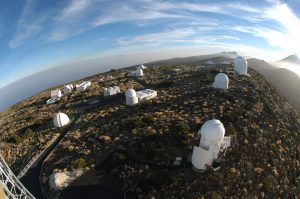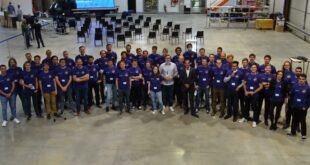
The geostationary Earth orbit (GEO) satellite belt is a unique location above the earth affording a continuous line-of-sight to satellite uplink and downlink stations. The volume defined by this belt is large, but available slots are limited. During the last fifty years of the space age, this volume has become more crowded, as humankind has launched more and more satellites into this particular orbital regime, and satellites that suffered incapacitating anomalies and space debris have remained in the belt. The latter pose a hazard since they are uncontrolled, and the only way for satellite operators to avoid collisions with space objects is to maneuver. Knowing when and where to maneuver requires space situational awareness (SSA), but this is just one aspect needed to maintain safety of flight in this very valuable orbital regime. (M. Skinner)
Spacewatch Middle East Chief Operating Officer Torsten Kriening spoke with Dr Mark Skinner in Berlin about orbital debris.
Dr Skinner, welcome to Berlin. The 2nd International Conference and Exhibition on Satellite & Space Missions on July 21-23, 2016 brought you to the dynamic city again. You are presenting on Current issues in Space Situational Awareness and Space Traffic Management. Can you give our audience a short introduction to the topic please?
For over 15 years, I worked for Boeing on Maui, Hawaii, at the Air Force Maui Optical and Supercomputing (AMOS) site, conducting research into space debris and space situational awareness. I wanted to inform the current debate as to “where to spend the next dollar” as regards to how we conduct ourselves in space, as far as the long-term sustainable use of outer space is concerned. In my paper, I try to outline what I feel are the four pressing threads (international collaboration, enhanced space surveillance, space object data sharing, and, space debris mitigation), and how they line up as to their effectiveness and how they should be prioritized in the near future. All four are worth doing, but for example, it isn’t clear that doubling the effort on international collaboration (e.g., UN COPUOS meetings) would double the output. Where we seem to be now is that there are a lot of individual efforts to collect data on space objects that are their own Silos (or “cylinders of excellence”). Data are collected, but then in most cases nothing more useful than a conference papers becomes of it. Several of us in the community have proposed the founding of a participant-funded “international space object data exchange” (“ISODEX”), and this has been an area of discussion at the UN COPUOS. Once that is in place, it makes a lot of sense to bring together the disparate sources of space object data that exist today, and expand that effort (possibly by STEM outreach) to nations that have an interest in getting into space, but perhaps aren’t yet at the level of development that would allow them to build and launch their own satellites. Yet at the same time we need the international work to develop guidelines and best practices to keep the current situation in space from deteriorating, as well as we need to look to the future, when it may become necessary to actually take action to remove space debris, or at least to prevent predicted collisions. There is a subtle interplay between these four areas, and I try to draw this out.
Space Situational Awareness is something that requires everyone’s attention and awareness, but the reality looks different. How can we change that? What is needed to spread the word in your opinion?
I think that researchers in SSA are very well aware of the effort, but that more awareness of the situation needs to be broadcast to other actors in the space arena, such as insurers, space lawyers, policy experts, as well as the actors in the “new space” domain. Today it seems that just about anyone can have a cube-sat place in orbit, but it isn’t clear that everyone understands the responsibilities that come along with these new opportunities. I feel that there is both an educational component to this, as well as a regulatory component that will help assure space will be “there” for everyone that desires to utilize it in the future.
This conference is a very technical and engineering oriented one. As you mentioned it is a global effort to undertake to save our planet and safe our space infrastructure. SpaceWatch Middle East is very focussed on the new space powers in the Middle East. How can they support your mission? How are the involved already?
Boeing offers commercial space situational awareness services for commercial space operators (and others), and a Middle East operator was one of our first customers. I think that shows a savvy knowledge of the need to utilize all fonts of SSA information; both their own in-house knowledge, as well as that provided by US Space Command. Boeing offers additional “niche” services that help to fill in the gaps for the operators in a very cost-effective manner. Additionally, we have been in discussion with a Middle Eastern university about hosting a suite of telescopes to both provide STEM outreach to students and faculty, as well as to participate in an ISODEX prototype amongst a small consortium of international universities. There are a number of precocious space efforts underway in the Middle East, and a number of Middle Eastern countries have recently joined the international discussion at the UN COPUOS, to everyone’s greater benefit.
SpaceWatch Middle East thanks Dr Mark Skinner for this interview.
Dr. Mark Skinn er joined Boeing in 1999 as a senior scientist and technical manager with the Science & Analysis (S&A) team on Maui, Hawaii, where Boeing operates the Maui Space Surveillance System for the Air Force Research Laboratory (AFRL). The S&A group conducts research into observational and analysis techniques to advance the state of the art in space surveillance. In 2015 he joined Boeing Research & Technology in Albuquerque NM.
er joined Boeing in 1999 as a senior scientist and technical manager with the Science & Analysis (S&A) team on Maui, Hawaii, where Boeing operates the Maui Space Surveillance System for the Air Force Research Laboratory (AFRL). The S&A group conducts research into observational and analysis techniques to advance the state of the art in space surveillance. In 2015 he joined Boeing Research & Technology in Albuquerque NM.
Skinner specializes in the techniques of non-resolved object characterization (NROC) and non-imaging space object identification (NISOI), and has extended this research into both the infrared and time domain arenas. His current research focus is on the detection and characterization of orbital debris, with an emphasis on debris in the geosynchronous orbital regime (GEO).
He is currently the PM of Boeing’s Commercial ground-based SSA thrust being conducted with the Boeing Satellite Systems Customer Support group in support of Boeing’s commercial satellite customer base. The project aims are to develop techniques and technology that would provide space situational awareness information for conjunction analysis and anomaly resolution to GEO satellite owners and operators.
Skinner received a Bachelor of Science degree in physics, and a Bachelor of Science in the Humanities and Science from the Massachusetts Institute of Technology. He received a Doctor of Philosophy in experimental astrophysics from the University of Wisconsin-Madison, and a Masters of Business Administration from the International Space University in Strasbourg, France.
Original published at: http://spacewatchme.com/2016/07/current-issues-in-space-situational-awareness-and-space-traffic-management/
 SpaceWatch.Global An independent perspective on space
SpaceWatch.Global An independent perspective on space

